Ten Days of Adventure in the Australian Wilderness
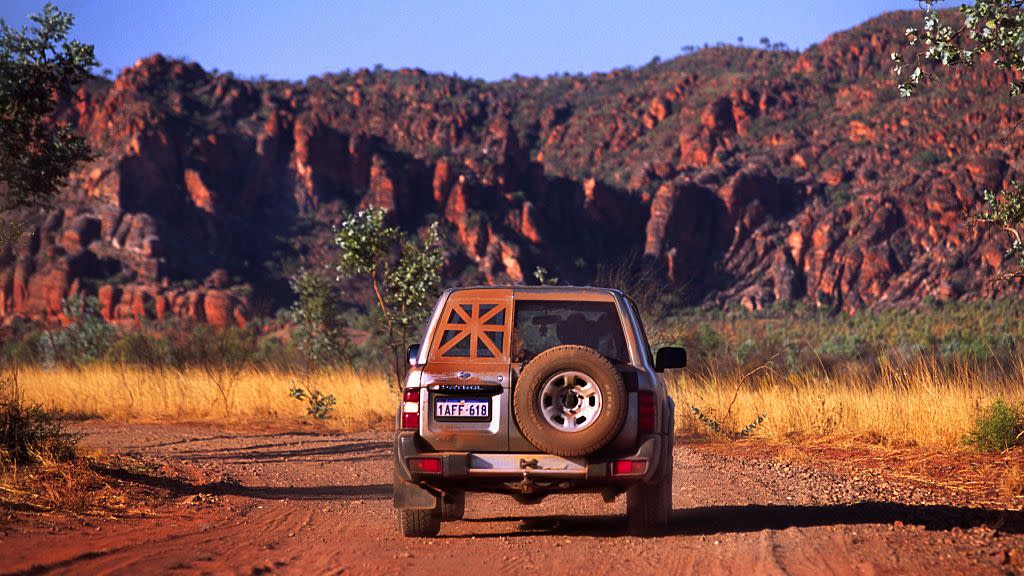
On the lookout for crocodiles. That’s how we spent much of our trip to the Kimberley region of Western Australia, one of the most remote, uninhabited places on earth. The “salties,” or saltwater crocs, are known as ambush predators that can strike unexpectedly, while the “freshies” are a separate species of crocodile that live in freshwater and are supposedly less dangerous to humans—although I wasn’t that convinced. It’s said that there are more crocodiles than people in the Kimberley. I’d agree with that.
When we weren’t thinking about the crocs, we were looking out for kangaroos, wallabies, wallaroos, dingos, emus, flocks of corellas, century-old baobab trees, and ancient dinosaur prints. We saw them all.
To travel to this part of the world, you need a robust sense of adventure. You have to be willing to give yourself up to the wonders of the bush and to acknowledge the indigenous people who have lived on this land for more than 50,000 years.
You’ll also need to be comfortable flying in small planes that land on dirt runways on distant cattle stations, riding in helicopters that land in deep sandstone gorges, avoiding snakes on hiking trails, riding horseback across rivers, and wearing khaki shorts, boots, and kangaroo skin hats (to fit right in with the locals).
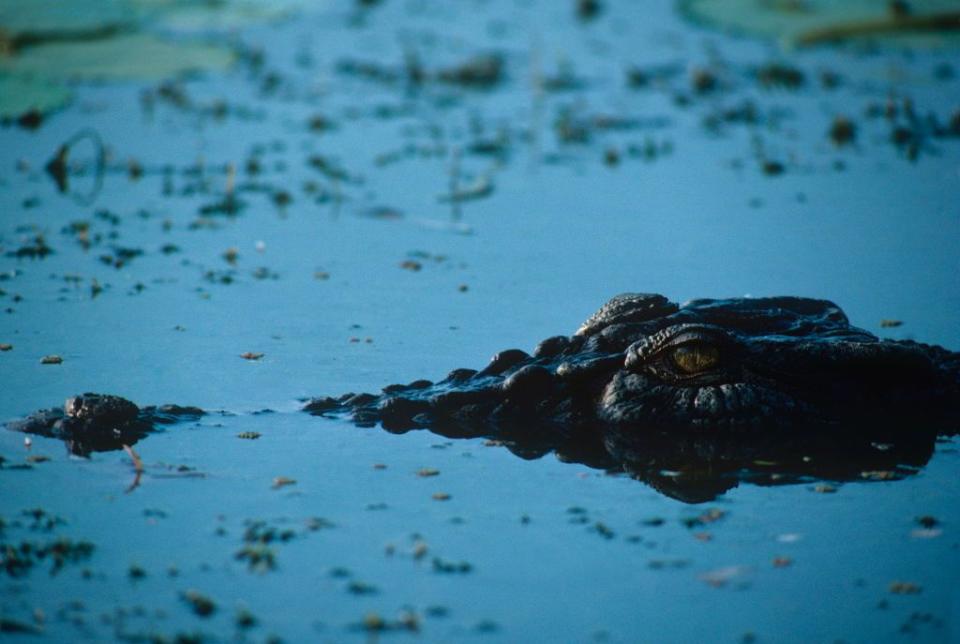
Western Australia—typically called “WA” by Aussies—is easily the largest of the country's six states and three internal territories, though not nearly the most populous. WA is geographically massive, at nearly a million square miles, but it has a population of just 2.8 million. (For comparison’s sake: India is 1.24 million square miles in size with a population of 1.4 billion.) And more than 2 million of WA’s residents live in the territory’s stunning capital city of Perth and its environs, situated on the southwest coast along the Indian Ocean.
The Kimberley region in the north is 163,521 square miles (about the size of California) with less than 40,000 inhabitants. It’s made up of vast open spaces with rugged landscapes and endless savannas. Locations like the town of Kununurra, the Purnululu national park, and the Bungle Bungle Range take time and distance to reach. Most people fly from place to place. But one can also take a 4WD along the legendary Gibb Road, a 600-kilometer old cattle-driving route. Gazing out the window at the outback as you drive, it feels like you’ve been dropped into an episode of the HBO series The Tourist, starring Jamie Dornan.
Every year, my adventure travel group and I pick a new place to explore—the more far flung and less-traveled the better. We’ve traversed Ethiopia, hiked to Everest Base Camp, tracked the lemurs in Madagascar, and more. This time, Leslie, Marty, Mihaela, Tom and I were joined by a new traveler, Ric, who fit right in with our group. We had an instinct that the Kimberley might just be the next big thing for us, and it didn’t disappoint.
Most people who travel to WA arrive in Perth, one of the most remote cosmopolitan cities on the planet. My friend Steve, an American who moved there more than 30 years ago when he married Helen, a “Perthian,” familiarized us with his beautiful, adopted city. From King’s Park to the neighborhoods of Cottesloe, Fremantle, and Claremont, we absorbed this laid back, sophisticated and stylish city—one of the best kept secrets in the world.
After a few days there, we headed north for our ten-day visit to the Kimberley. With the help of Perth-based travel agent Sue Warry, we were able to put together a unique itinerary that would let us experience this wild and largely untouched part of the world.
We took the nearly three-hour flight to Broome, known as the gateway city to the region. As is the custom upon landing throughout Australia, the flight attendant acknowledged the traditional owners of the land, past, present and emerging, a recognition of the indigenous communities and their cultural and spiritual relationships to the country. The Australian government has played a significant role in creating national respect for the history of the indigenous people. In the Kimberley alone, there are more than 230 aboriginal communities scattered across the landscape, many inaccessible to visitors.
Pat Mamanyjun Torres, a local Djugun Elder and owner of a company that harvests Australian native foods in Broome, performed a welcome smoking ceremony for us in the Yawuru Conservation land, something that only an indigenous individual can do. Torres lit seven herbal medicine plants—including lemongrass, sandalwood, and broad leaf paperbark—and spread the smoke onto different parts of our body to welcome us to her ancestral home. An indigenous scholar, Torres holds degrees in language and linguistics and is currently working on a second master’s to record and preserve the Djugun language, one of 700 indigenous languages in the country.
We’d been there for a day when we had our first croc episode. Cable beach, a twenty-two-kilometer stretch of gorgeous white sand, that could be up to a kilometer wide from sea to dunes when the tide is out, was closed near our access at the Cable Beach Resort due to a croc sighting. The locals seemed to take it all in stride. Just a part of Broome life, explained Candy Evans, our local guide, suggesting that if we wanted to learn more about crocs we should visit Malcom Douglas Crocodile Park.
We had plenty to see and do in the area, learning about the pearl diving that has taken place in the region since the 1800s. We explored the red rocks of Gantheaume Point, complete with dinosaur footprints and experienced the staircase to the moon, a unique phenomenon when a full moon rises over the tidal flats of Roebuck Bay, creating an illusion that you can walk a staircase to the moon!
My favorite moment in Broome was at the gorgeous sunset hour on Cable Beach (now clear of the croc), when families and friends drive their 4WDs with kids and dogs in tow, bringing local beers from Matso’s Brewery and food to watch the sun sink onto the horizon. For added measure, you can ride camels along the beach for an even more unique view. (Tourist alert: we couldn’t resist.)
We did make our way to the Crocodile Park, home to 3,000 of the largest reptiles in the world. Some can live to 70 years or older, growing to 16 feet long and weighing well over 1,000 pounds. As the ranger tossed raw chicken parts during a feeding, we saw how swiftly they could move when it comes to food of any kind.
Early one morning, we headed to the local airport to board a Cessna 210 for the two-hour flight north to Mount Hart, where we would explore deep red rock gorges via helicopters. Our pilot, Lucy, a former flight attendant who had decided that she would rather be at the front of the plane, regaled us with stories about the area, including the “thousands of salties” below in King Sound, off of the Dampier Peninsula.
As a private pilot myself, and not wanting to be a crocodile’s breakfast, I kept an eye on our altitude, happy that Lucy deftly rose another 1,000 feet just in case we had an issue and would have to glide safely to nearby land. Did I mention that there are also sharks in the same water? In a moment of gallows humor, we debated which would be our least favorite fate: Being eaten by crocs or sharks.
We landed on a dirt strip at Mount Hart Wilderness Lodge, a former cattle station set up with en suite safari tents for visitors who want to spend time deep in the heart of the Wunaamin Conservation Park. After a quick welcome coffee, we transferred to two helicopters to begin several hours of zigzagging through the deep sandstone gorges, while taking in the splendor of the rusty pink oxidized rock formations. Our pilot Luke and guide Fabio surprised us by landing on a flat slate of rock only to be greeted by two staffers from the Lodge, who had a breakfast of fresh fruits, croissants, sandwiches, and champagne waiting for us.
After breakfast, we took a swim in fresh water in the Twin Flames gorge, assured that there were no freshies to worry about. Instead, we were greeted by a twenty-inch lizard—known as a water monitor in these part—that slithered out of the water just in front of us. At first, we wondered how many more of his friends were with him. But we didn’t wait long to find out, deciding to cut short our swim. Tom, a veterinarian, christened him “the wonderful lizard of Oz.” And we hopped back on our choppers to return to the lodge.
As Lucy flew us back to Broome over the spectacular Horizontal Falls (known as Garaanngaddim by the local indigenous people), we watched the swirling waters squeeze between narrow cliff passages creating the actual waterfalls. Flying down the western side of the Dampier Peninsula with salties visible from the air, we saw no other sign of life. The golden sunset glistening on the land below conjured up images of the 2008 move Australia, filmed in these parts.
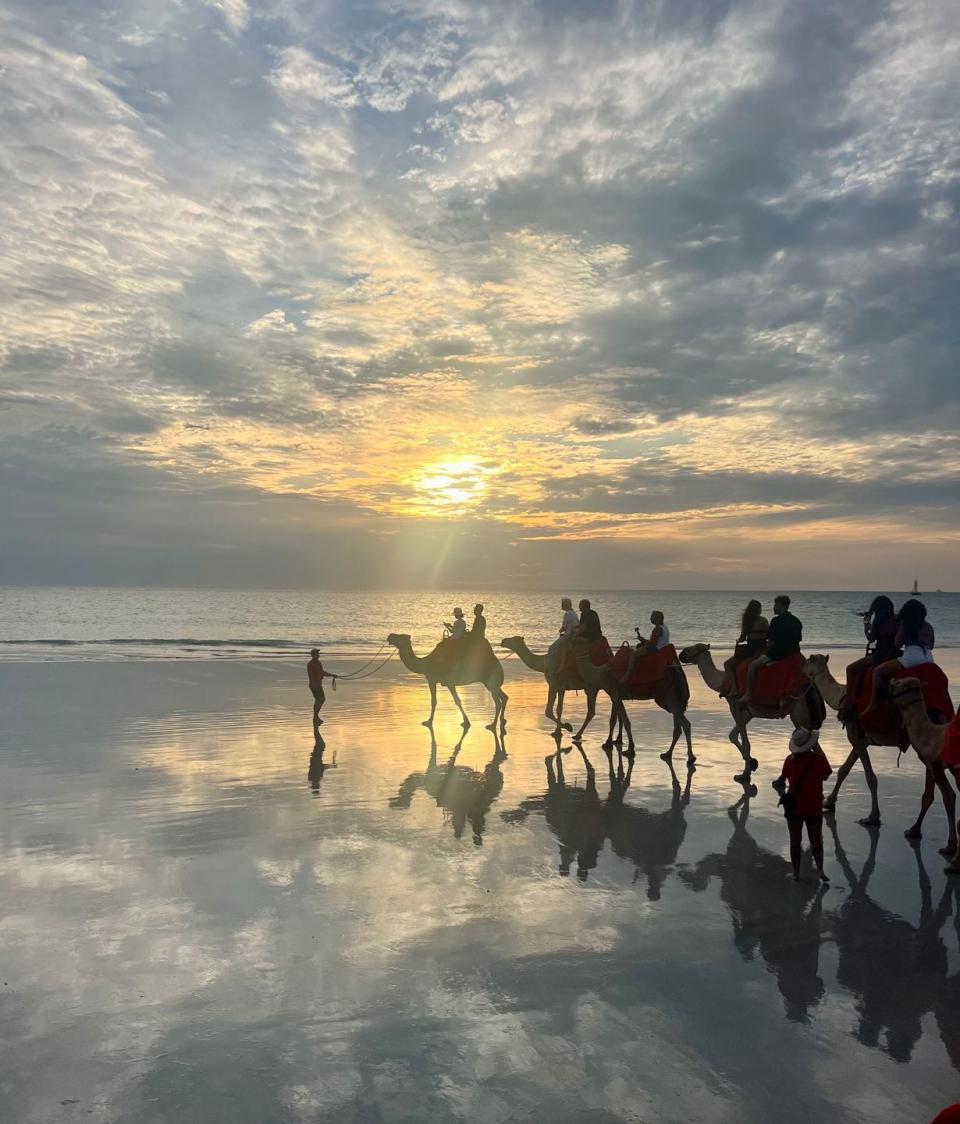
On day four, we took a ninety-minute commercial flight aboard a Nexus Q400 from Broome to Kununurra (“big water” in the local aboriginal dialect), then piled into a 4WD Land Rover for a ninety-minute ride to one of our main destinations, where we would spend four days in the outback.
El Questro is a 700,000-acre property that is accessible only by dirt road from the Gibb highway. It was originally over one million acres. But in 2022, the owners, G’day Group, signed an Indigenous Land Use Agreement, returning several hundred thousand acres to the Ngarinyin people. Done in partnership with the Wilinggin Aboriginal Corporation, the effort is an historic first land deal to extinguish legacy leases over former pastoral land and return it to traditional owners. The agreement will create a unique cultural and tourism relationship with El Questro and the indigenous community.
At El Questro, there is something for every traveler: raw campsites with no power; small tents with power access; eight Riverview huts; sixty safari cabins at nearby Emma Gorge; and The Homestead, a luxury retreat (spoiler alert: that’s the place to stay if your budget will allow it).
Jodie Mott, the general manager, is right out of central casting, wearing a long skirt and boots, a welcoming smile, and a long blond braid that cascades down one shoulder. Originally from Queensland, she has spent twelve years managing remote properties throughout WA. Overseeing a seasonal staff of 130, she was getting ready for the busy time of year when we arrived.
“We have an international staff who come for the season,” she said, adding that there are two seasons in the area, wet and dry. The dry season from the beginning of May through November is when El Questro is open. During the wet season, the roads are impassable.

At the station’s general store, we met travelers from around the world, including several “gray nomads,” or Australians who travel the country for a year or more.
It's here that you can also book hikes, helicopter rides, and other excursions while having a cappuccino prepared, as you discuss the day with the guides. Throughout our trip, we never met another American tourist (although on our first morning in Perth, we were surprised to run into Caroline Kennedy, the U.S. Ambassador to Australia, in our hotel lobby).
The Homestead is fifteen kilometers further into the bush from the central station at El Questro. Nestled on a hilltop with sweeping views of the Chamberlain River gorge, it is a ten-room oasis nestled within thirty frangipani trees and palms. It was here that we met the famous Vinnie, a twelve-foot-long croc who trolled the waters just below the ridge. Throw a pebble into the water and you will see him stealthily appear.
We could have walked down a set of stone steps to get a closer look at him, but we were advised that Vinnie is a bit unpredictable and always hungry. Just watching him slide quietly past us was enough to send chills up our spines, as we were convinced that he was watching our every move and just waiting for us to approach him.
Everything is included in your stay at the Homestead, from the gourmet menu to the open bar to guides who can help you explore the area. One highlight is the gigantic 900-year-old baobab tree on the property.
At El Questro, days are filled with a broad choice of adventures. We took multiple hikes, my favorite being the Emma Gorge Walk, an hour-long trek over rocky terrain that led to a dramatic waterfall (there are at least six major trails in the area). We traveled by open-air 4WD to watch the sunset from Saddleback Mountain and walked through a forest of Livistona palms and spinifex to get to Zebedee Springs, where we spent some time cooling off in the pools of water.
On many of our hikes it got very hot, so being prepared was a constant concern. In the middle of the season, it can get to 100 degrees Fahrenheit or more. Not only is it critical to cover up and slather on sunscreen but also to pay attention to the “pee charts” in the restrooms with five different shades of urine to let you know if you are over-hydrating or under-hydrated.
Our boat ride along the Chamberlain River (please don’t put your hands in the water as we have lots of crocs here, said our guide) glided through huge rock formations that are 1.8 billion years old. We stopped at a fish sanctuary to watch the seven-spotted archerfish. If we waved our hand above them, they would spit water at us, signaling to give them a treat.
Archerfish are one of the only fish species that hunts for food outside of water, capturing mosquitos and other flying insects through these spitting techniques.
It was here that we also learned about the Barramundi, the local fish that is on most menus. They spend the first seven years of life as males in salt water and then turn into females, as they travel into fresh water. They then return to the salt water to mate with the new crop of males.
One of my favorite moments at El Questro was heading out for a two-hour horseback ride through savanna grasses that were taller than us. Our horses trotted to the top of neighboring hills and open vistas, allowing Tom and Ric, both seasoned riders, to gallop across the open bush.
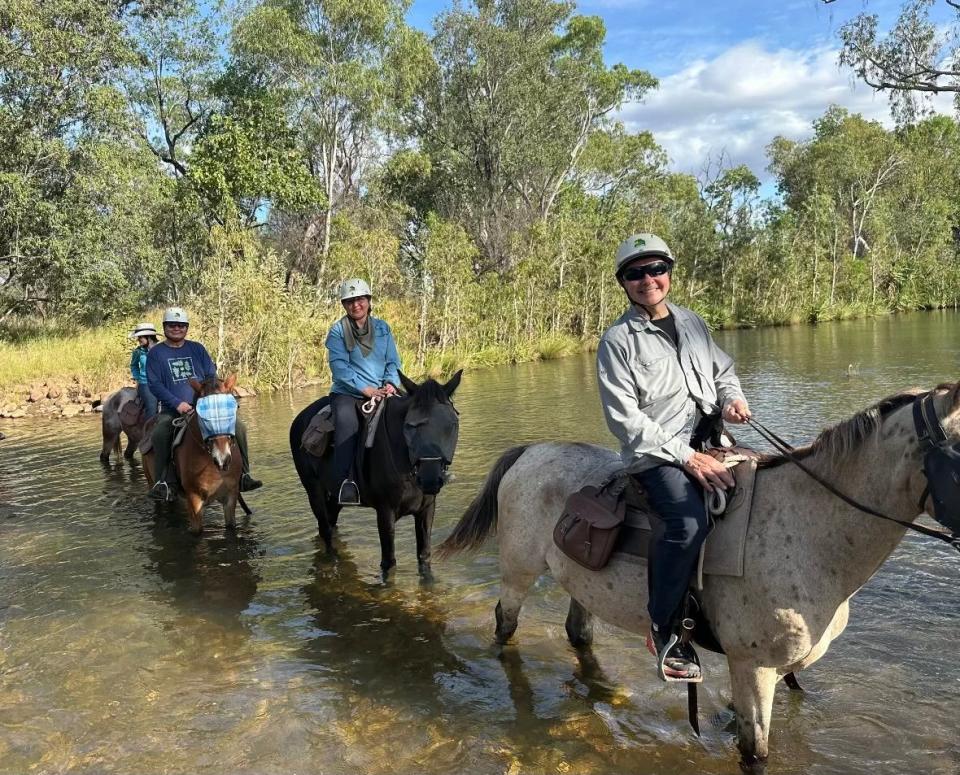
We saw the red-tailed black cockatoos and the Blue Winged Kookaburra birds. Our horses waded across Moonshine Creek and the Pentecost River. Before starting, our guide would check the white Styrofoam balls anchored in the water to look for any crocodile bites. If there were none, it was safe to go, but at times the water could be up to the horse’s stomach, which meant that our feet were in the water.
What if a croc hadn’t bit the Styrofoam and was lurking somewhere below, I thought, taking my feet out of the stirrups just in case.
Driving back to Kununurra, we spent an unforgettable evening with husband-and-wife team Josh and Tamsyn, who host an open-air outback gourmet dinner experience just outside of town amidst giant baobab trees.
We watched the sunset above the neighboring red cliffs, while dining on a crocodile appetizer (which tasted a bit like sausage), prepared over open flame with a touch of native pepper berry, along with main courses of barramundi and pork belly. It was all washed down with a local ginger beer. he setting was a perfect way to spend an Australian evening.
The next morning, we boarded a twelve-seater Cessna Caravan for the one-hour flight to Purnululu National Park (an aboriginal word for sandstone), which was listed as a World Heritage Site in 2003. This spectacular 600,000-acre park is managed by traditional owners, the Gija and Jaru people who have lived there for centuries and the Parks and Wildlife service.
Flying over Lake Argyle, our pilot Chavanne casually mentioned that there are an estimated 30,000 crocodiles in the lake below. I found myself checking our altitude (again) and scouting where we might land if we had any kind of engine trouble. We flew over the Argyle Diamond Station, which ceased operation in 2020 after producing more than 865 million carats of rough diamonds, and then reached one of the most spectacular views of the trip.
Purnululu is the home of Bungle Bungle Range, a dramatic set of beehive domes which were formed over 360 million years ago. Known only by the aboriginal people in the area, they were discovered by the outside world in 1983, when a group of “mustering” pilots (who drive cattle from airplanes) mentioned it to a visiting film crew in the area.
Travelers can now visit the Bungles to experience their otherworldly shapes. Chavanne maneuvered the plane into full circles so that we could see them from different angles. Even though they’re ancient, they are fragile, we learned from our guide, who told us that they probably only have another million years before they are gone.
“Let’s hope that the planet is still around in a million years!” said Marty.
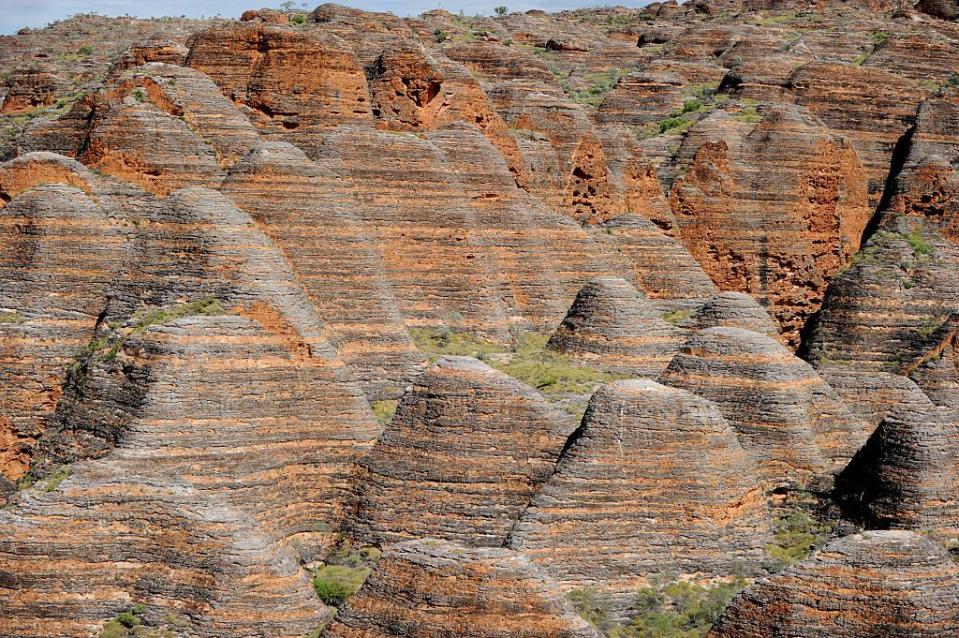
You can’t climb the Bungles. They are only there to be observed and admired, a gigantic stone sculpture garden sitting in the middle of nowhere. They are geological poetry and we imagined that the indigenous people who saw them 50,000 years ago experienced them the same way that we were seeing them now.
In the Purnululu, there are also some great short hikes that are awe-inspiring.
We chose Cathedral Gorge, a trail that led to a wide-open space with acoustical perfection, and the Echidna Chasm, a long narrow trail across rocks and boulders, that was sandwiched between transparent massive rock formations, letting in the crystal blue skies into the crevasses below. After a full day, we headed to the charming Savannah Lodge, an outback camp with comfortable cabins and a welcoming bar and dining area where we all traded stories with the other guests.
Throughout our visit, we found ourselves de-stressing from our busy urban lives. In the Kimberley, the outside world doesn’t exist. Even though we had internet, we all decided to take a tech break. Instead, we focused on the pure air, the silence, the majestic vistas, and the landscapes beneath our feet, and tried to be 100 percent present to take it all in.
We listened to the birds, learned about the native trees and plant life from our guides, and didn’t pay attention to time. We went to sleep early and woke up with the sunrise. It was both mind-cleansing and spiritual.
Ric, who is Navajo, said, “In the vast expanse of Western Australia, I discovered a sense of belonging that resonated with the spirit of my Navajo roots, where the land and culture embraced me as a kindred soul, weaving a tapestry of connection that felt like coming home.”
If you want to experience something completely unique, a frontier land that is reminiscent of the American West, go to this part of the world before it gets overrun. It will release your own pioneer spirit in a way that is hard to find anywhere else.
Yes, we were always on the lookout for the crocs, but ultimately, it was all very safe. The idea of confronting an enormous reptile was more frightening than the reality. However, I still dream about Vinnie. For some reason, I can’t get his sinister gaze out of my mind.
You Might Also Like

